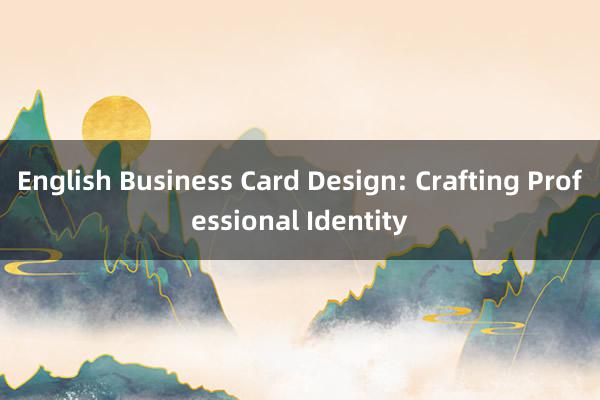English Business Card Design: Crafting Professional Identity

### English Business Card Design: Crafting Professional Identity
In the digital age, where virtual connections often precede in-person meetings, a well-designed business card remains a tangible representation of one's professional identity. This article delves into the art and science of creating an English business card that not only impresses but also effectively communicates your professional message.
#### 1. **Purpose and Audience**
- **Understanding Your Role**: Whether you're a seasoned executive or a startup entrepreneur, your business card should reflect your role within the organization. It's crucial to tailor its design to suit your professional position and industry standards.
- **Target Audience**: Consider who will receive the card. Is it for clients, potential employers, or business partners? The design should resonate with your audience's expectations and preferences.
#### 2. **Design Elements**
- **Personal Information**: Include your name, title, and company logo prominently. For an English audience, using clear,苏州普塔拉商贸有限公司 readable fonts is essential. The font size should be large enough to be easily read from a distance.
- **Contact Information**: Typically, 鑫数建模型科技(上海)有限公司 include your phone number, 小程序管理系统 email address, and website URL. Depending on the context,负极旧小程序测试 adding social media handles can also be beneficial.
- **Additional Information**: Depending on the job role, consider including secondary contact information such as a fax number or LinkedIn profile link.
#### 3. **Visual Appeal**
- **Color Scheme**: Choose a color scheme that aligns with your brand identity. Use colors that are appealing yet professional. Contrasting colors can make your card stand out without being overwhelming.
- **Graphics and Images**: Incorporate relevant images or icons that complement your profession. For example, a lawyer might use a gavel icon, while a graphic designer could feature a stylized pencil or computer icon.
- **Layout**: A clean layout with balanced elements ensures readability and aesthetic appeal. Avoid overcrowding the card with too much text or graphics.
#### 4. **Material and Finish**
恩平市静名石灰有限公司- **Card Stock**: Opt for high-quality card stock that feels substantial in the hand. This material choice enhances the perceived value of the card.
- **Finishing Touches**: Consider adding a glossy or matte finish to enhance the visual appeal. Embossing, perforations, or rounded corners can add a unique touch without compromising functionality.
#### 5. **Inclusivity and Accessibility**
- **Language**: Ensure that the card is easily understandable by non-native English speakers if necessary. Using simple, clear language and avoiding jargon can facilitate international communication.
- **Accessibility Features**: For visually impaired individuals, consider including Braille contact details or ensuring the card is accessible through a QR code linking to digital contact information.
#### 6. **Distribution Strategy**
- **Networking Events**: Hand out cards at conferences, seminars, or networking events where you meet potential contacts.
- **Business Meetings**: Exchange cards during formal meetings to establish professional relationships.
- **Online Presence**: Share your digital business card on social media platforms and professional networks like LinkedIn.
By focusing on these aspects负极旧小程序测试, you can create an English business card that not only serves as a physical reminder of your professional identity but also enhances your personal and professional network. Remember, a well-designed business card is a reflection of your professionalism and commitment to building lasting relationships in the business world.
